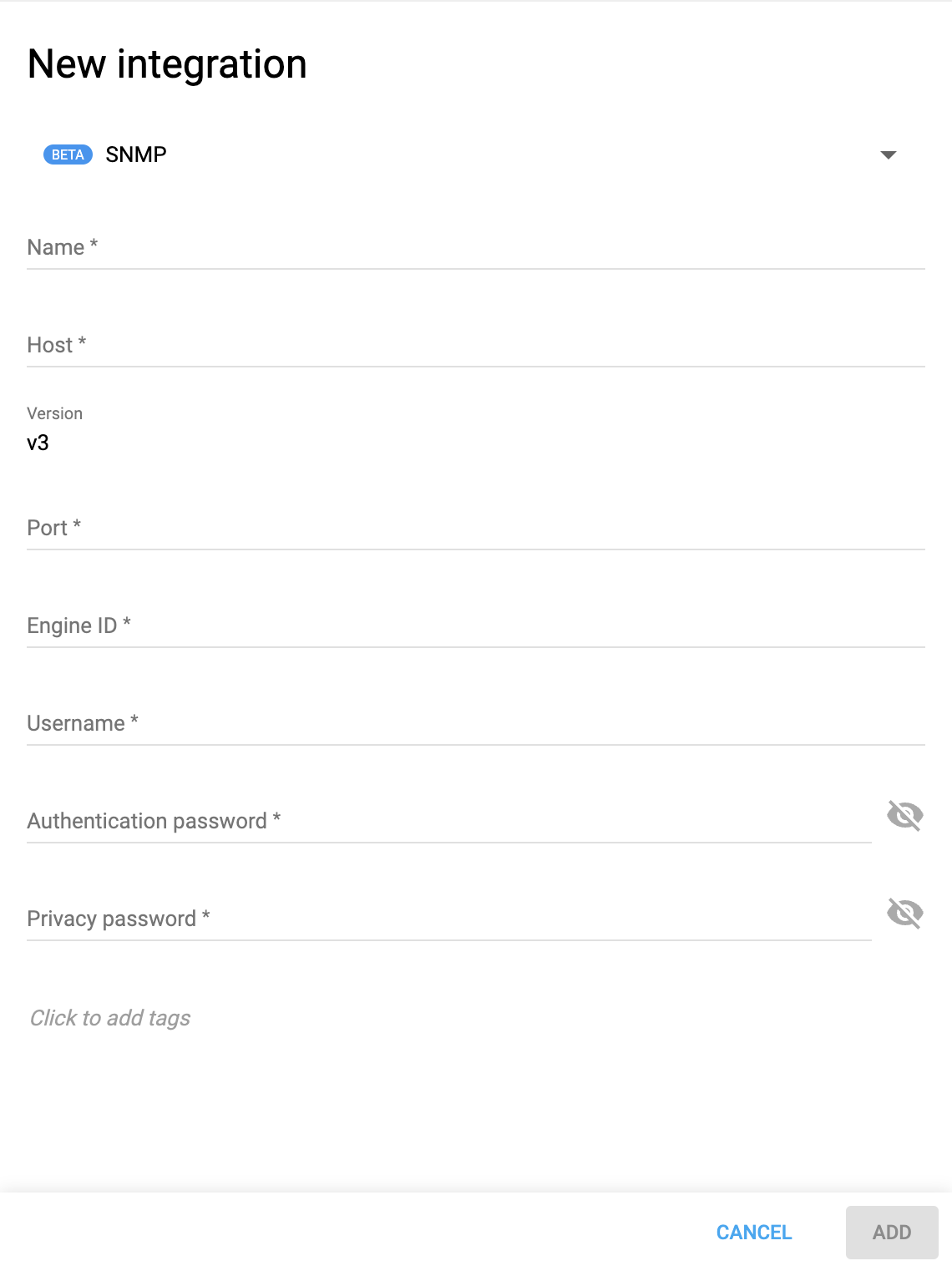SNMP Integration
Last Updated: 2023-12-19
Purpose
The purpose of this article is to guide organizations in configuring SNMP integration.
Introduction
This guide explains how to configure SNMP integration to enable Outscan to forward network device events to an external SNMP server for centralized monitoring. Using SNMP (Simple Network Management Protocol), administrators can collect real-time metrics (for example, device up/down status, CPU, memory, interface traffic), trigger alerts on threshold breaches, and maintain asset inventory. Correct setup of host parameters, authentication (username, auth & privacy passwords), Engine ID, port, and retry intervals is essential to ensure reliable communications between Outscan and the SNMP agent. Notification rules must also be defined so that relevant events are forwarded to the SNMP management system.
Description
SNMP (Simple Network Management Protocol) is a widely used network management protocol in the field of computer and network administration. SNMP is designed to monitor and manage network devices, servers, and other hardware and software components on a network. It enables network administrators to gather information, set configurations, and monitor the performance of devices and applications in real-time.
Here's an overview of what SNMP is and what SNMP integration can do:
Monitoring Network Devices: SNMP allows you to monitor various aspects of network devices such as routers, switches, servers, printers, and more. It provides real-time data on device status, resource utilization, and performance metrics like CPU usage, memory, bandwidth, and interface status.
Alerts and Notifications: SNMP integration can generate alerts and notifications when predefined thresholds or conditions are met. For example, it can send alerts when a device goes offline, experiences high CPU utilization, or reaches a certain level of disk space usage.
Configuration Management: SNMP enables administrators to remotely configure network devices. You can change settings, update firmware, and perform other configuration tasks without physically accessing the device.
Asset Inventory: SNMP can be used to create and maintain an inventory of network assets. It provides details about the devices in the network, including their manufacturer, model, firmware version, and more.
Performance Analysis: SNMP data can be used for long-term performance analysis and trend monitoring. By collecting historical data, you can identify patterns, plan for capacity upgrades, and optimize network performance.
Security Monitoring: SNMP integration can help monitor security-related events by providing information on intrusion detection, firewall status, and security policy compliance.
Remote Troubleshooting: SNMP allows remote troubleshooting of network issues. It provides visibility into device status and configuration, making it easier to diagnose and resolve problems without physical access to the devices.
Third-Party Integrations: SNMP can be integrated with various network management and monitoring tools, allowing for centralized control and automation of network tasks.
SNMP is a crucial protocol for managing and monitoring network infrastructure. SNMP integration extends its capabilities by integrating it with other network management systems, allowing organizations to efficiently monitor, manage, and optimize their networks for performance, reliability, and security.
About the Solution
The integration enables the platform to relay events to an external SNMP server for centralized monitoring and analysis. For these events to manifest in the configured system effectively, it is imperative to establish proper notification settings. Configuring notification settings involves defining rules and parameters for when specific events or thresholds are met, ensuring that relevant information is promptly communicated to the configured integration. For guidance on configuring these notification settings, visit Notifications Settings.
Add Integration
To add a new integration, follow these steps:
Click on the green
 button located in the lower-right corner of the browser window.
button located in the lower-right corner of the browser window.Select the desired integration configuration type from the drop-down menu.
Fill in the necessary parameters.
Click Add to finish the integration.
Integration fields overview

Option | Description |
|---|---|
Integration | The selected integration type determines the available fields, which vary based on the chosen integration. |
Name* | Descriptive name of the integration. |
Host* | Remote host implementing SNMP. |
Port* | The port at which the remote host listens for SNMP messages. |
Engine ID | Unique identifier for an SNMP entity, used to distinguish and address specific devices. |
Retry Interval | Denotes the time interval between consecutive retry attempts made by the SNMP manager when no response is received from the SNMP agent. |
Username* | Identification credential used for authentication when accessing SNMP-enabled system |
Authentication password* | Validates the authenticity of SNMP messages, ensuring that communication is secure and authorized. |
Privacy password* | Encrypts SNMP messages to maintain confidentiality, safeguarding the exchanged information. |
*) Mandatory
Related Articles
- CyberArk Integration
- Delinea Integration
- General Information about SMB/WinRM Scanning
- Integration Management
- Portal Integration with ServiceNow Incidents
- SNMP Integration
- Syslog Integration
- Webhook Integration
- Webhook Integration with JIRA
- Webhook Integration with Microsoft Teams
- Webhook Integration with OAuth v2
Copyright
© 2026 Outpost24® All rights reserved. This document may only be redistributed unedited and unaltered. This document may be cited and referenced only if clearly crediting Outpost24® and this document as the source. Any other reproduction and redistribution in print or electronically is strictly prohibited without explicit permission.
Trademark
Outpost24® and OUTSCAN™ are trademarks of Outpost24® and its affiliated companies. All other brand names, product names or trademarks belong to their respective owners.
